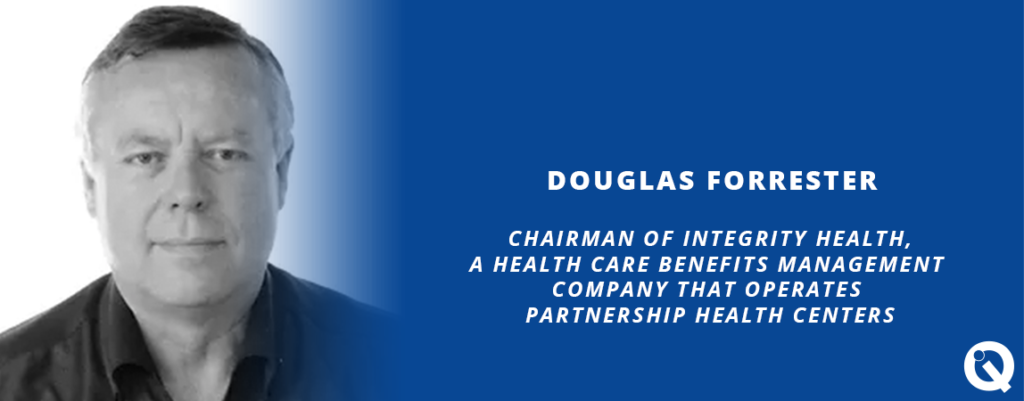Douglas Forrester is Chairman of Integrity Health, a health care benefits management company that operates Partnership Health Centers. Integrity Health is a member of the Quality Institute.
Partnership Health Centers employs a unique patient-centered model of care. What makes your model different?
I’m not aware of any organization with an outpatient setting that has brought together and integrated so many different primary care provider disciplines. We have physicians, a laboratory, X-rays, a full pharmacy, behavioral health services, physical therapy, chiropractic, and acupuncture — all under one roof and one team-structured practice, led by a family practice physician. We bring all these elements together with care coordination for those using the Partnership Health Center as well as those using outside providers. We also have on-site Member Advocates, who trouble-shoot benefit coverage and provider claim problems. Those using Partnership Health Center don’t pay co-pays and there is little to no wait time. Patients don’t have to worry about disputes about deductibles or benefit limits because there are none. Same-day appointments, one-stop shopping, and no copays mean our health centers are enormously popular.
People can just focus on getting and staying well. We manage our Partnership Health Center as the hub of a health plan for an employer, county, or school district. The self-funded health plans reimburse the expenses of the health center. The doctors, nurses and pharmacists and others receive a salary, without any financial conflicts of interest that could compromise care. Best-practice medicine is our focus. We have an online tour for anyone who wants to learn more.
How does a health center model benefit employers looking for both high quality care and cost containment?
When I talk to executives, I often ask, “Why do you offer a health care plan to employees?” They say, “Well, we’ve always had one.” Or, “It’s negotiated in the contract.” Someone might say it’s to recruit and retain good employees. All those answers are correct, but ultimately, the reason is to promote health so that employees and their loved ones are productive at work and play. There is so much focus on annual premium rates and access to big networks — and the big discounts that everybody likes — but, although we use networks with great discounts, those elements have nothing to do with health. There is no data showing that the size of a network or discounts produces better health outcomes. What produces better health outcomes is access to primary care and full coordination with specialists if needed.
Rising health costs, in my opinion, are a direct result of us collectively forgetting our philosophy and what we are trying to accomplish. If we look at public employee health benefits — where people tend to stay in the same job for 20 years or more — we see the financial benefits of early care. We empower employees to realize that early intervention and a home base for primary care gets people the care they need as quickly as possible — and we can coordinate with specialists if necessary. We head off downstream problems. Our model addresses patients’ health issues before they become expensive and unmanageable.
What is the impact of your model?
Our most conservative estimates are that, on average, we return $2 for every dollar invested. That would be the easiest way to put it. But when you’re talking about large amounts of money in terms of health plan spend, that adds up. When you have robust health facilities … doctors, primary care providers, acupuncture, and other needed services you are spending money but getting money back by keeping people as healthy as possible. The only way to reduce costs is to create better outcomes. I can tell you that the average clinic numbers nationally are about five to five-and-a-half visits per employee per year. Our numbers are almost twice that. People are happy with the program, and they vote with their feet.
You recently launched a clinic specifically for New Jersey first responders. Why is this so important and how will it work?
Our first responder initiative is a little different. It began when the head of a first responder union in New Jersey came to me and said, “Doug, we’ve heard you’re doing good things with Partnership Health Center for public employers, can you do something for us? I’ve just come from my sixth member funeral where a correction officer has taken his own life.” The conversation evolved to include other first responder union leaders, such as fire services, and state and local police. Police are facing the strain of responding to increased calls for psychiatric crises and other stressors. There are a lot of issues having to do with behavioral health and mental health services such as anxiety and severe depression. We created the First Responders Partnership Health Center exclusively for first responders that will offer same-day doctor visits, labs, x-rays, and prescriptions. We’ll offer pain management and behavioral health services. We’re integrating mental health within primary care. And we have acupuncture, physical therapy, and other services. There may be a mental health issue, but that may not be the reason someone originally sought care. The model is different from our other services, though, in that we will be billing the first responders’ insurance carriers. We have a good partnership in this sense, with the State Health Benefits Program and its plan Administrator, Horizon.
Where can we find you on your days off outside of work?
What I am doing is a labor of love and it takes up a portion of each day. But when I am not working, I’m enjoying my family and now my grandchildren. They bring me so much joy. For recreation, I read in the fields of politics, economics, and theology, swim, and play chess. I am also on a couple of boards of New Jersey non-profits. They are unrelated, yet their purposes dovetail to address serious challenges to our democracy posed by lack of civic engagement and economically marginalized entrepreneurs.

